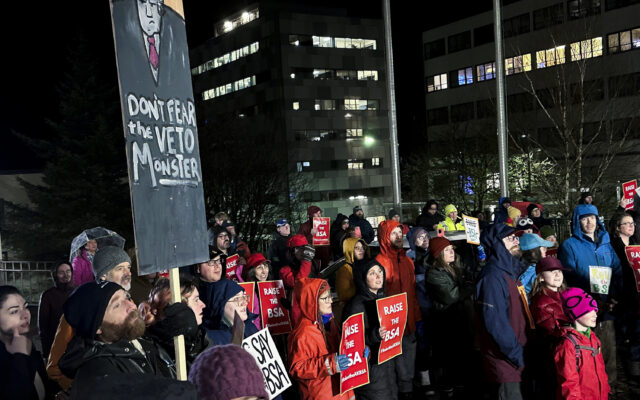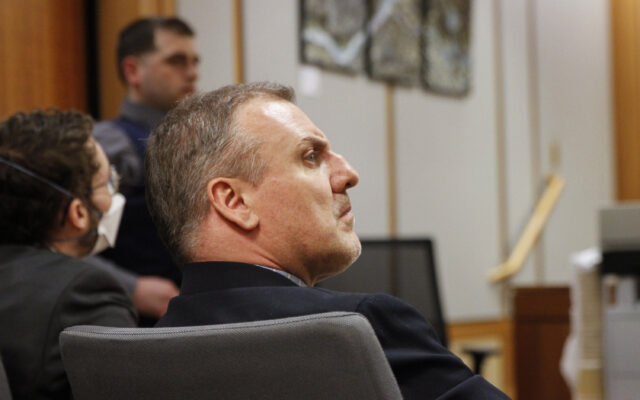A high cost of living and lack of a pension strain teachers in Alaska. Would bonuses help keep them?

JUNEAU, Alaska (AP) — Cory Hughes moved to a remote Alaska village to teach and would happily stay and retire there if he could afford to — despite the dark winters and the fact the bathroom for his housing unit in the school’s kindergarten building has a sink that comes to his knees.
But Alaska is the only U.S. state that does not offer teachers a pension, and researchers say teacher pay and benefits have not kept up with other states. Hughes has bought a house in Ohio and he’s wondering how long he can remain in Nunapitchuk, the southwest Alaska village with a population of 525 he has come to love.
“I’ve taught for seven years, and my retirement wouldn’t even last me, like, a few months,” said Hughes, 28. “So I know that my time here is going to have to come to an end at some point, probably sooner than later.”
School funding is dominating the Legislature as lawmakers meet nearly 1,000 miles (1,600 kilometers) away in Juneau. Districts are facing teacher shortages and, in some cases, multimillion-dollar deficits. They say unpredictable levels of state support tied in part to Alaska’s fluctuating oil wealth make long-term planning nearly impossible.
Schools have had to cut programs, increase class sizes or have teachers and administrators take on extra roles. Hughes was tapped to help coach basketball, a sport he had not played.
Teacher turnover is nothing new, and Alaska is not alone in struggling to fill positions. But the effects can be acute in high-cost, hard-to-reach communities that rely on barges or planes for supplies, places so remote they sometimes have polar-bear patrols to keep residents safe. Eggs can cost more than $9 a dozen in some areas.
Republican Alaska Gov. Mike Dunleavy, a former educator, is promoting charter schools and a three-year program that would test whether paying teachers annual bonuses of $5,000 to $15,000 keeps them on the job — with higher amounts going to those in the most remote districts.
Dunleavy questions whether simply bolstering state aid to K-12 schools will turn around Alaska’s dismal performance in reading and math assessments. Alaska led the country in the share of students who missed at least 10% of the 2021-22 school year, and there has been an increase in the number of kids who are homeschooled since the pandemic.
School officials aren’t necessarily opposed to the bonus idea but say districts simply don’t have the resources they need. They are seeking a large, permanent increase in the state’s per-student funding formula to counter the toll of inflation and high energy and insurance costs.
“We can’t improve things if we’re always scrambling for crumbs,” said Erica Kludt-Painter, superintendent in the fishing community of Petersburg. Her district’s budget has been augmented by federal and grant funds but is now “at the breaking point,” she said.
Alaska residents get a yearly check from the state’s oil-wealth fund, and there’s no personal state income tax. Those are often billed as perks, but lawmakers over the last decade have struggled with budget deficits tied to the volatility of oil prices. They have had little appetite for considering new taxes as the state has continued drawing down savings and relying on oil-wealth-fund earnings to help pay the bills.
Even some lawmakers sympathetic to school officials’ pleas question whether the roughly $360 million more they are seeking is politically realistic. The state provided about $1.3 billion to K-12 school districts for the current budget year. Lawmakers approved a one-time, $175 million boost, but Dunleavy vetoed half that.
Some districts, including Alaska’s largest in Anchorage, have been recruiting teachers from overseas. A group that’s been involved in past litigation against the state over the adequacy of school funding is weighing another lawsuit.
The state Senate passed a bill to reinstate pensions — nearly 20 years after lawmakers closed the system — but its prospects are unclear. Majority House Republicans proposed legislation that includes Dunleavy’s bonus plan, charter provisions and a roughly $80 million increase in aid to districts through the formula — an amount many lawmakers consider inadequate. It faced early opposition on the House floor Monday, with lawmakers deadlocking in an initial vote on whether to bring it up for debate. Some lawmakers said provisions of the bill weren’t sufficiently vetted.
“It’s not rocket science in the sense that it is a combination of compensation and working conditions that attract and keep teachers in schools,” said Dayna DeFeo, director of the Center for Alaska Education Policy Research. “We can’t just buy our way out of it, but that is definitely going to have to be a part of it.”
Hughes was seeking adventure and a “different view of the world” when he became a social studies teacher at a K-12 school in Nunapitchuk about seven years ago. He saw the central role schools play in such small communities when he was invited to a funeral at the school the day after he arrived.
He immersed himself in the predominantly Alaska Native village’s culture to avoid feeling isolated, especially during what he described as a “make or break” first year in rural Alaska. He enjoys the hunting and fishing lifestyle.
There are challenges: the school is near the top of a state list for major reconstruction needs. The village faces threats from climate change. Thawing permafrost is undermining infrastructure.
It’s unclear whether the proposed bonuses aimed at full-time teachers would apply to Hughes. While he supervises some online classes, he is currently the dean of students. He doesn’t have the degree to be an administrator and is paid as a teacher, he said.
Independent Rep. Rebecca Himschoot, a retired teacher from Sitka in southeast Alaska, said lawmakers should figure out how to pay for what districts say they need. Otherwise, schools may not be able to offer athletics, art, theater or other aspects of a well-rounded education.
“What is the school system we want to have?” Himschoot said. “Because we’re really quickly headed for the school system that doesn’t offer the opportunities that people in my generation all had.”



